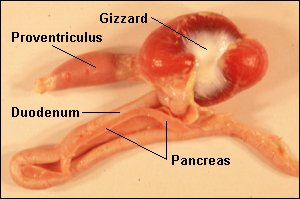VIVO Pathophysiology
Digestive Anatomy and Physiology of Birds
The avian cuisine varies as much as in mammals, leading to classification of individuals as carnivores, insectivores, seed-eaters and the like. As a consequence of these behavioral and dietary adaptations, a number of variations are seen in digestive anatomy of different birds. Having recognized that, however, common features of the avian digestive tract can be described.
The Pregastric System
The mouth of birds distinctly different from mammals. They have no teeth and their jaws are covered by a beak, which is seen in remarkably different forms. Birds do not really masticate, and mechanical disruption of food is accomplished by the beak and gizzard.
The esophagus is large in diameter, particularly in birds that swallow large meals. Swallowing is accomplished by esophageal peristalsis, and in most birds appears to be aided by extension of the neck. Most but not all birds have a crop, which varies from a simple expansion of the esophagus to one or two esophageal pouches. Depending on the state of contraction of the stomach, food being swallowed is diverted into the crop, then later propelled into the stomach by waves of peristalsis in the crop.
Stomachs
Birds have a glandular stomach, or proventriculus, and muscular stomach or gizzard. The glandular stomach receives food from the esophagus, and secretes mucus, HCl and pepsinogen, similar to what is seen in the mammalian stomach. The gizzard is a disk shaped, very muscular and in many birds contains small stones that facilitate grinding of foodstuffs. One of the gizzard's two orifices receives ingesta from the glandular stomach and the other empties into the duodenum.

A complex cycle of contractions involving the two stomachs force feed back and forth between the two, grinding it and increasing exposure to digestive enzymes. There is also periodic retropulsion of duodenal contents back into the stomachs, again presumably facilitating mixing of ingesta with enzymes. A final type of motility is seen in the regurgitation of pellets of bones, hair and feathers from the stomach of raptors.
Small Intestine
Birds have a small intestine that seems very similar to the small intestine of mammals. A duodenum, jejunum and ileum are defined, although these segments are not as histologically distinct as in mammals. The proximal small intestine receives bile from the liver and digestive enzymes from the pancreas, and the absorptive epithelial cells are decorated with essentially the same battery of enzymes and transporters as in mammals.
Large Intestine
The large intestine consists of a short colon and, typically, a pair of ceca. Short villi extend into the lumen of the colon, unlike what is seen in mammals. The cloaca is an expanded, tubular structure that serves as the common opening of the digestive, reproductive and urinary systems, which opens to the outside of the bird as the vent.
As in mammals, the large intestine's primary function is absorption of water and electrolytes. Antiperistalsis that originates in the cloaca is a prominent pattern of motility in the avian colon and has been suggested to assist not only in filling the ceca, but to flush urine from the cloaca into the large gut for absorption of water. In some birds, the ceca appear dispensible and can be removed without apparent harm. In other species, the ceca are important sites for fermentation, and the volatile fatty acids generated from microbial digestion of cellulose contributes significantly to energy demands.
Send comments to Richard.Bowen@colostate.edu
